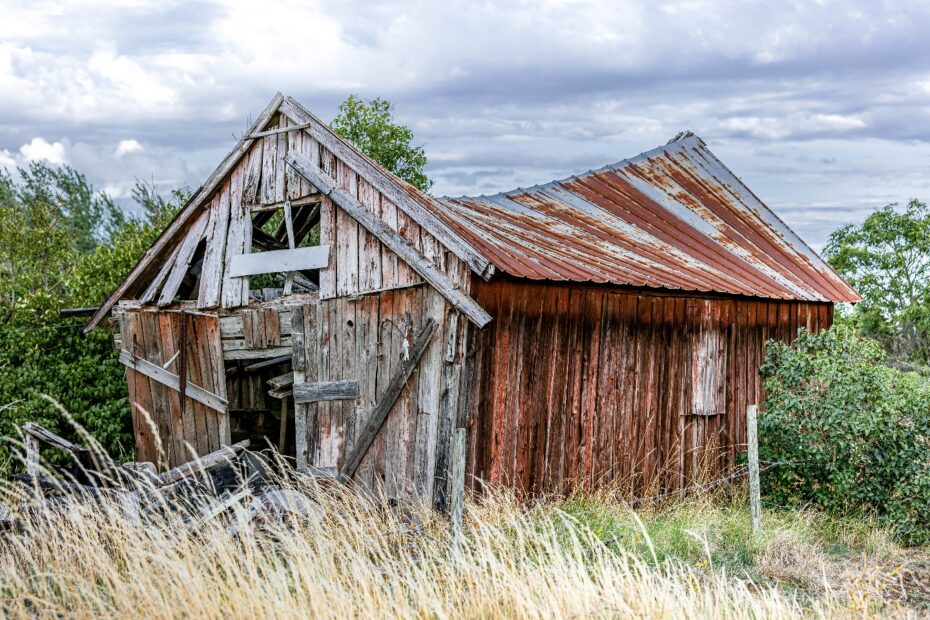Traditionally a post frame building foundation is made from simple footings with wood posts extending below the frost line. With wood in the ground, there is potential for rot at the grade line. Pole barn wood decay can cause your entire storage building to collapse, which can be very dangerous and expensive.
Not everyone feels comfortable putting lumber in the ground, for fear of rot. These fears are typically unfounded. When the site is properly prepared and the lumber is properly treated, it is highly unlikely that the wood post will rot.
If you aren’t persuaded, you do have other pole barn foundation options. Concrete piers, called permacolumns, are very similar to post-in-ground with a minimal cost increase.
What Causes Pole Barn Wood Decay?
Post decay can happen when three things combine: oxygen, moisture, and ambient temperatures above freezing. With a properly prepared site and properly treated wood, post decay is almost unheard of. Note: that does not say “treated” wood. That says “properly treated” wood. At Michigan Building Design, our pole barns plans specify good site drainage and pressure-preservative treated lumber to meet standard UC-4B.
Most off-the-shelf lumber at your nearest home improvement store is going to be UC-4A “general use.” UC-4B lumber is “heavy duty” ground-contact rated treatment. You may have to special order UC-4B lumber, but any lumber supply vendor can get it.
Our post-frame building plans typically specify laminated posts rather than solid lumber. Both will work, but laminated posts are treated all the way through, whereas a solid lumber treatment may not fully penetrate the column. There are other reasons to use laminated posts as well, they are straighter, less prone to warping, and they are stronger.
With UC-4B laminated posts and proper site preparation, it is likely that your pole building won’t rot even in your grandchildren’s lifetime.
What Does Science Say About Pole Barn Wood Decay?
How long will it take these posts to rot? No one knows the exact answer, but the National Forest Service cites a study called “Long-Term Durability of Pressure-Treated Wood in a Severe Test Site.” This study gives us an idea of the minimum expectations. The authors of the study tested treated lumber in the “harsh decay environment” of southern Mississippi, with high rainfall, warm temperatures, and termites. The American Wood Protection Association (AWPA) rates this as the highest severity of deterioration zone: level 5.
In this study, water-borne treated wood (a UC-4B requirement) experienced zero failures in over 60 years. By comparison, untreated lumber experienced a 100% failure rate in just 2.4 years.
The authors are careful not to extrapolate pressure-treated wood durability for less harsh environments, but note that the results suggest the study may “underestimate potential durability in more northern climates.”
All of Michigan is in the Level 2 deterioration zone, as rated by the AWPA. It’s likely that pressure treated wood is far more durable in our northern climate. Another factor is that pressure-treatment and construction materials have improved since the beginning of the study in 1937.
In summary, the science tells us that pole barn wood decay should be very low on your list of concerns.
Post Protectors or Grade Guards
To get the benefits of post-in-ground columns, some people look to other options to mitigate rot. Manufacturers have developed plastic sleeves called post protectors or grade guards. These may cover the entire in-ground portion of the post, or just the grade-level portion of the post. The design of these sleeves allows moisture to evaporate, and they are an inexpensive option for additional protection.
We do not recommend them. It can be tough to keep them sealed and there is always potential for them to hold moisture in and create a rot-friendly environment.
If You Want to Build to Last, Have a Licensed Structural Engineer Review Your Plans
Post-frame buildings are popular because they are inexpensive, durable, and versatile. While they may not be costly to build, having a structural engineer review and stamp your building plans can protect your investment.
A structural engineer will ensure that your pole building can effectively handle the forces of high wind and heavy snow. If you want to build to last, an experienced engineer can help you avoid costly mistakes.
At Michigan Building Design, we offer affordable rates and expedient turn-around time. If you’d like us to take a look at your pole barn plans, or design a building to suit your needs, call us at (231) 577-9523 or fill out our online contact form. We offer engineer sealed plans in the state of Michigan.
